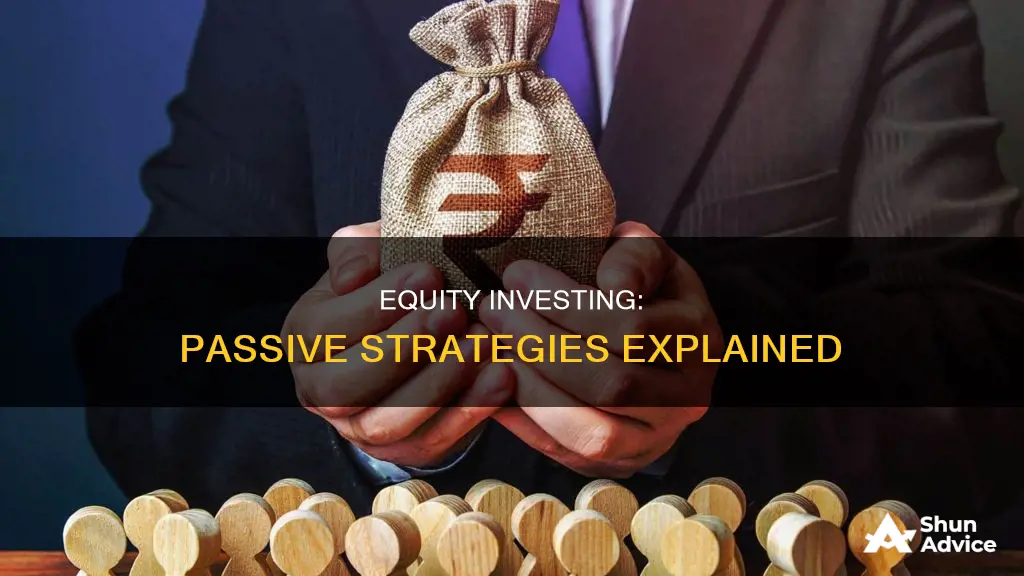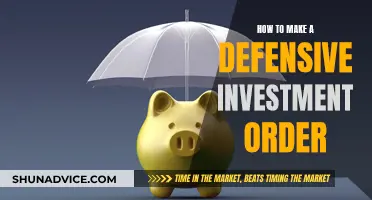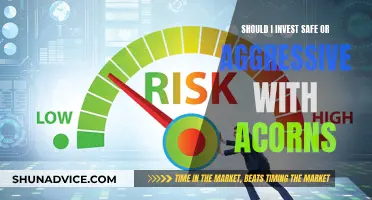
Passive equity investing is an investment strategy that aims to maximise returns by minimising the costs of buying and selling securities. It is a passive strategy because it does not require investors to actively hunt for investments. Instead, investors purchase the securities in a representative benchmark, such as the S&P 500 index, and hold them for a long time. This form of investing is less expensive and complex than active management, and it often produces superior after-tax results over medium to long time horizons. Passive equity investing is also known as indexing, referring to strategies that intend to replicate the performance of benchmark indexes.
| Characteristics | Values |
|---|---|
| Definition | A passive fund is an investment vehicle that tracks the stock market and replicates its performance |
| Performance | Passive funds track the performance of the index they’re linked to, such as the MSCI World or FTSE 100 |
| Risk | The risk of passive funds is similar to that of active funds but studies show that passive funds tend to perform better over long periods of time |
| Objective | To deliver returns that are in line with the current stock market |
| Management | Passive funds don't have a fund manager deciding which securities to invest in |
| Investment | Passive funds don't pick which investments to hold in the fund, meaning that any returns will depend on the performance of the index the fund is tracking |
| Commonly tracked market | FTSE 100 |
| Passive fund example | Exchange-Traded Funds (ETFs) |
| Advantages | Lower fees, greater tax efficiency |
| Disadvantages | Smaller short-term returns compared to active investing |
What You'll Learn

Passive equity investing vs active investing
Passive equity investing is an investment strategy that aims to maximise returns by minimising the costs of buying and selling securities. It is a long-term, buy-and-hold strategy, where investors seek to replicate and hold a broad market index or indices. Passive investing is typically done by investing in a mutual fund or exchange-traded fund (ETF) that mimics the index's holdings.
Passive investing is less expensive and complex than active investing. It is also more tax-efficient, as the buy-and-hold approach does not trigger large annual capital gains tax. However, passive investing may result in smaller short-term returns compared to active investing.
Active investing, on the other hand, involves buying and selling investments based on their short-term performance, with the aim of beating average market returns. Active investing requires a hands-on approach, typically by a portfolio manager, and involves a deeper analysis of when to pivot into or out of a particular stock, bond, or asset.
Active investing offers more flexibility, as managers are not required to hold specific stocks or bonds and can use hedging strategies such as short sales or put options. It also allows for better tax management, as managers can tailor strategies to individual investors, such as selling investments that are losing money to offset taxes on winning investments.
However, active investing is more expensive due to the higher fees associated with active buying and selling, as well as the salaries of the analyst team. It also carries more investment risk, as managers are free to buy any investment they believe will bring high returns, which can be detrimental if they are wrong.
In summary, passive investing is a more hands-off approach that aims to minimise costs and provide returns with less risk over a longer period. Active investing, on the other hand, is a more hands-on approach that aims to beat the market and can provide bigger returns but comes with greater risk. Both strategies have their advantages and disadvantages, and many investment advisors blend the two approaches to take advantage of the strengths of each.
Impact Investment Managers: Creating Positive Change
You may want to see also

Advantages of passive equity investing
Passive equity investing is a strategy that aims to maximise returns by minimising the costs of buying and selling securities. It is typically done by investing in a mutual fund or exchange-traded fund (ETF) that mimics the index's holdings.
Lower Costs
Passive investing is less expensive than active management. Passive funds have much lower fees and greater tax efficiency. Passive funds are typically operated automatically, which reduces their running costs. Passive fund managers do not need to be paid, so fees are generally much lower than those charged by active fund managers. Passive funds also tend to have lower minimum investments and are more tax-efficient than active funds.
Long-Term Performance
Passive investing often produces superior after-tax results over medium to long time horizons. Passive funds tend to perform better over long periods. The market has always gained ground over time, and passive investors expect this pattern to continue in the long run.
Simplicity and Transparency
Passive investing is less complex than active management. It simplifies the portfolio construction process and reduces fees triggered by frequent trading. Passive investing is also transparent—it is clear which assets are in a passive fund.
Reduced Risk
Passive investing reduces the risk of making poor investment decisions. Passive fund managers do not need to be concerned with market timing or spotting individual "diamond in the rough" stocks. Passive funds are also less risky than buying shares in individual companies.
Time Efficiency
Passive investing saves time by removing the need to research and decide which securities to own. Passive investors do not need to spend time actively hunting for investments.
Diversification
Passive investing enables investors to achieve diversification. Passive funds spread risk by holding securities in their target benchmarks or a representative sample of those securities.
Performance Consistency
Passive funds consistently perform in line with the market. Passive fund managers do not need to worry about underperforming the market because the funds are designed to replicate market performance.
Investment Models in India: Understanding the Fundamentals
You may want to see also

Disadvantages of passive equity investing
Passive equity investing is a strategy that aims to maximise returns by minimising the costs of buying and selling securities. It is typically done by investing in a mutual fund or exchange-traded fund (ETF) that mimics the index's holdings. This is in contrast to active investing, which involves a hands-on approach and requires someone to act as a portfolio manager.
Limited Flexibility
Passive funds are limited to a specific index or set of predetermined investments. They are typically allowed to make few, if any, changes. Therefore, investors are locked into those holdings, regardless of market conditions. This lack of flexibility can be a disadvantage when compared to active investing, where managers can buy individual stocks they believe are undervalued or exit specific stocks or sectors when the risks become too high.
Smaller Potential Returns
By definition, passive funds rarely outperform the market and usually return slightly less due to operating costs. They are designed to provide returns that closely track their benchmark index, rather than outperform it. This is because passive funds are limited to a specific index and their core holdings are locked in to track the market. On the other hand, active investing can bring bigger returns, but it also comes with greater risks.
Reliance on Fund Managers
Passive investors generally rely on fund managers to make investment decisions. They may not have a say in what they are invested in, which can be a disadvantage for those who want more control over their investments. Active investors, on the other hand, can choose to buy individual stocks or exit specific investments as they see fit.
Market Performance Risk
Passive investing returns are closely tied to the performance of the index being tracked. If the index experiences a downward price trend, the passive investing fund will likely follow suit. This can be a disadvantage during market downturns or periods of high volatility. Active investors, on the other hand, can adapt to adverse market conditions and shift their positions to benefit from a bear market.
Higher Costs Over Time
While passive investing generally has lower fees than active investing, the difference in costs may appear small in the short term. However, over time, the impact of these fees on investment returns can be significant. For example, the higher fees associated with active investing may result in a lower overall return compared to passive investing over two decades.
India's Investment Potential: Why You Should Invest
You may want to see also

Index funds
Another risk of index funds is the lack of flexibility. Fund managers are usually prohibited from using defensive measures such as reducing a position in shares of particular securities, even if they think those share prices will decline. Additionally, index funds face performance constraints and are designed to provide returns that closely track their benchmark index, rather than outperforming it. They rarely beat the return on the index and usually return slightly less due to operating costs.
529 Plans: Exploring Investment Portfolios for Education Savings
You may want to see also

Exchange-traded funds (ETFs)
ETFs are a popular passive investment vehicle, particularly in Europe. They are often chosen for their lower fees and greater tax efficiency compared to active funds. Passive funds, in general, have dramatically lower costs than actively managed funds because they are typically operated automatically rather than by a fund manager. Passive funds also tend to perform better over long periods.
ETFs can provide investors with exposure to diverse markets, such as ESG strategies and thematic ETFs, which enable investors to invest in specific themes like Artificial Intelligence or Healthcare. It is worth noting that some ETFs can be actively managed.
ETFs are a good option for those who don't have the time or inclination to research active funds, as they keep fees to a minimum and ensure investors won't lag behind the stock market. However, as with any investment, due diligence is required. Investors need to select an index that aligns with their investment objectives.
ETFs are also more tax-efficient than many index funds. When an ETF is sold, it is typically sold to another investor, so capital gains taxes are the responsibility of the individual investor. In contrast, when cash is redeemed from an index fund, the fund manager sells securities from the fund, and if there are net gains, these are passed on to all investors with shares in the fund.
ETFs do come with some risks. They can only be bought and sold on stock exchanges, and in extreme market scenarios like a crash, there may not be enough demand to sell. ETFs also carry a concentration risk because they are often made up of top stocks and sectors weighted according to market capitalisation. Therefore, if a few stocks perform poorly, the whole ETF could be negatively impacted.
Indexing vs Active Management: Why Indexing Wins
You may want to see also
Frequently asked questions
Passive equity investing is an investment strategy that aims to maximise returns by minimising the costs of buying and selling securities. Passive investors seek to replicate and hold a broad market index or indices.
Passive equity investing is less expensive and complex than active management, and it often produces superior after-tax results over medium to long time horizons. Passive investing also reduces the costs of selecting investments by simplifying the portfolio construction process and reducing fees triggered by frequent trading.
Passive equity investing lacks flexibility. Fund managers are usually prohibited from using defensive measures such as reducing a position in shares of particular securities, even if they think those share prices will decline.
You can invest in passive equity funds by buying shares in either index mutual funds or index exchange-traded funds (ETFs).







